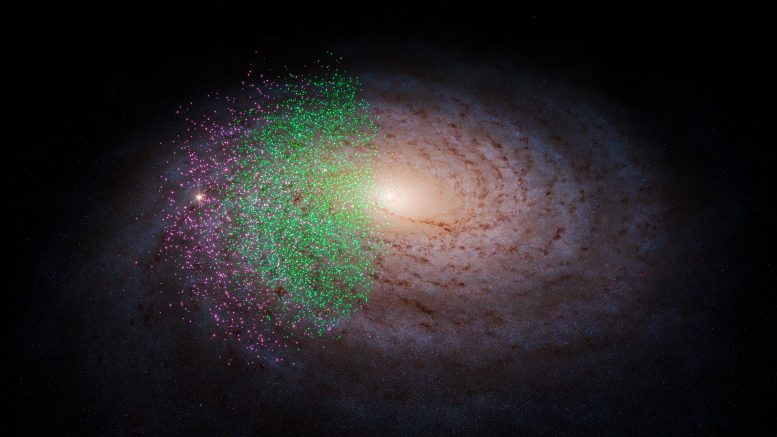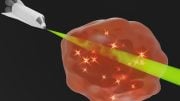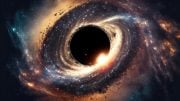
A visualization of the Milky Way galaxy, with the stars that Khyati Malhan and Hans-Walter Rix identified in the Gaia DR3 data set as belonging to Shiva and Shakti shown as colored dots. Shiva stars are shown in green and Shakti stars in pink. The complete absence of green and pink markers in some regions does not mean that there are no stars from Shiva or Shakti there, as the data set used for this study only covers specific regions within our galaxy. Credit: S. Payne-Wardenaar / K. Malhan / MPIA
Astronomers have identified what could be two of the Milky Way’s earliest building blocks: Named “Shakti” and “Shiva,” these appear to be the remnants of two galaxies that merged between 12 and 13 billion years ago with an early version of the Milky Way, contributing to our home galaxy’s initial growth. The new find is the astronomical equivalent of archeologists identifying traces of an initial settlement that grew into a large present-day city. It required combining data for nearly 6 million stars from ESA’s Gaia mission with measurements from the SDSS survey. The results have been published in the Astrophysical Journal.
The early history of our home galaxy, the Milky Way, is one of joining smaller galaxies, which makes for fairly large building blocks. Now, Khyati Malhan and Hans-Walter Rix of the Max Planck Institute for Astronomy have succeeded in identifying what could be two of the earliest building blocks that can still be recognized as such today: proto-galactic fragments that merged with an early version of our Milky Way between 12 and 13 billion years ago, at the very beginning of the era of galaxy formation in the Universe.
The components, which the astronomers have named Shakti and Shiva, were identified by combining data from ESA’s astrometry satellite Gaia with data from the SDSS survey. For astronomers, the result is the equivalent of finding traces of an initial settlement that grew into a large present-day city.
Tracing the origins of stars that came from other galaxies
When galaxies collide and merge, several processes happen in parallel. Each galaxy carries along its own reservoir of hydrogen gas. Upon collision, those hydrogen gas clouds are destabilized, and numerous new stars are formed inside. Of course, the incoming galaxies also already have their own stars, and in a merger, stars from the galaxies will mingle. In the long run, such “accreted stars” will also account for some of the stellar population of the newly-formed combined galaxy. Once the merger is completed, it might seem hopeless to identify which stars came from which predecessor galaxy. But in fact, at least some ways of tracing back stellar ancestry exist.
Help comes from basic physics. When galaxies collide and their stellar populations mingle, most of the stars retain very basic properties, which are directly linked to the speed and direction of the galaxy in which they originated. Stars from the same pre-merger galaxy share similar values for both their energy and what physicists call angular momentum – the momentum associated with orbital motion or rotation. For stars moving in a galaxy’s gravitational field, both energy and angular momentum are conserved: they remain the same over time. Look for large groups of stars with similar, unusual values for energy and angular momentum – and chances are, you might find a merger remnant.
Additional pointers can assist identification. Stars that formed more recently contain more heavier elements, what astronomers call “metals,” than stars that formed a long time ago. The lower the metal content (“metallicity”), the earlier the star presumably formed. When trying to identify stars that already existed 13 billion years ago, one should look for stars with very low metal content (“metal-poor”).
Virtual excavations in a large data set
Identifying the stars that joined our Milky Way as parts of another galaxy has only become possible comparatively recently. It requires large, high-quality data sets, and the analysis involves sifting the data in clever ways so as to identify the searched-for class of objects. This kind of data set has only been available for a few years. The ESA astrometry satellite Gaia provides an ideal data set for this kind of big-data galactic archeology. Launched in 2013, it has produced an increasingly accurate data set over the past decade, which by now includes positions, changes in position and distances for almost 1.5 billion stars within our galaxy.
Gaia data revolutionized studies of the dynamics of stars in our home galaxy, and has already led to the discovery of previously unknown substructures. This includes the so-called Gaia Enceladus/Sausage stream, a remnant of the most recent larger merger our home galaxy has undergone, between 8 and 11 billion years ago. It also includes two structures identified in 2022: the Pontus stream identified by Malhan and colleagues and the “poor old heart” of the Milky Way identified by Rix and colleagues. The latter is a population of stars that newly formed during the initial mergers that created the proto-Milky Way, and continue to reside in our galaxy’s central region.
Traces of Shakti and Shiva
For their present search, Malhan and Rix used Gaia data combined with detailed stellar spectra from the Sloan Digital Sky Survey (DR17). The latter provide detailed information about the stars’ chemical composition. Malhan says: “We observed that, for a certain range of metal-poor stars, stars were crowded around two specific combinations of energy and angular momentum.”
In contrast with the “poor old heart,” which was also visible in those plots, the two groups of like-minded stars had comparatively large angular momentum, consistent with groups of stars that had been part of separate galaxies that had merged with the Milky Way. Malhan has named these two structures Shakti and Shiva, the latter one of the principal deities of Hinduism and the former a female cosmic force often portrayed as Shiva’s consort.
Their energy and angular momentum values, plus their overall low metallicity on par with that of the “poor old heart,” makes Shakti and Shiva good candidates for some of the earliest ancestors of our Milky Way. Rix says: “Shakti and Shiva might be the first two additions to the ‘poor old heart’ of our Milky Way, initiating its growth towards a large galaxy.”
Several surveys that are either already ongoing or bound to start over the next couple of years promise relevant additional data, both spectra (SDSS-V, 4MOST) and precise distances (LSST/Rubin Observatory), should enable astronomers to make a firm decision on whether or not Shakti and Shiva are indeed a glimpse of our home galaxy’s earliest prehistory.
Reference: “Shiva and Shakti: Presumed Proto-Galactic Fragments in the Inner Milky Way” by Khyati Malhan and Hans-Walter Rix, 21 March 2024, The Astrophysical Journal.
DOI: 10.3847/1538-4357/ad1885








Astronomers have identified what could be two of the Milky Way’s earliest building blocks: Named “Shakti” and “Shiva,” these appear to be the remnants of two galaxies that merged between 12 and 13 billion years ago with an early version of the Milky Way, contributing to our home galaxy’s initial growth. According to topological vortex gravitational field theory, spin creates everything, spin creates the world.
All observable movements in the physical world are inseparable from the interaction of topological vortices, including human observational behavior itself.
The universe does not do algebra, formula or fraction. The universe is geometrythe, and is the superposition, deflection, and twisting of geometric shapes.
Today, we have already entered the era of the internet. With the help of artificial intelligence and big data, discussions on scientific knowledge have become open and transparent. However, a group of editors of so-called academic journals (such as Physical Review Letters, Nature, Science, etc.) are self-righteous and mystifying themselves. They only care about their own so-called sufficiently high priority rating, general significance, discipline, novelty, etc., and do not care about what science and pseudoscience are.
Science and pseudoscience are not determined by a publication, an organization or a person, nor by you or me, but by mathematics the final say. Physical models must be based on mathematics or mathematical models in order to be scientific, convincing, and in accordance with natural laws.
The origin of geometry lies in the concerns of everyday life. The branch of geometry (mathematics) known as topology has become a cornerstone of modern physics. Topological vortex and antivortex are two bidirectional coupled continuous chaotic systems. They exhibit parity conservation, charge conjugation, and time reversal symmetry. The synchronization effect is extremely important in their interactions. The synchronization effect of the superposition, deflection, and twisting of multiple or countless topological vortices will make spacetime motion more complex. To understand this complex world, physics should respect the authenticity of topological vortex in low dimensional spacetime, rather than simply relying on a few formulas, numbers, or imagined particles.
Spin is a natural property of topological vortices. Spin is synchronized with energy, spin is synchronized with gravitation, spin is synchronized with time, spin is synchronized with evolution. The perpetually swirling topological vortices defy traditional physics’ expectations. One physical properties of topological vortices is them to spontaneously begin to change periodically in time, even though the system does not experience corresponding periodic interference. Therefore, in the interaction of topological vortices, time is both absolute and relative,and physics often requires treating space and time at the same level.
Low-dimensional spacetime matter is the foundation of high-dimensional spacetime matter. Low-dimensional spacetime matter (such as topological vortex) can form new material structures and derive more complex physical properties via interactions and self-organization. It is extremely wrong and irresponsible to imagine low dimensional spacetime matter using high-dimensional spacetime matter,such as a cat in quantum mechanics.
Science must follow mathematical rules. For example, the Standard Model (SM) is considered to be one of the most significant achievements of physics in the 20th century. However, the magnetic moment of μ particle is larger than expected, revealed by a g-2 experiment at Fermilab, suggests that the established theory (such as SM) of fundamental particles is incomplete. Furthermore, the SM omitting gravitation, it not involved the time problem and when the particle movement starts. Mathematics is the foundation of science. Physics must respect the scientific nature of mathematics and mathematical models. The SM must be based on mathematical models in order to be scientific, convincing, and in line with natural laws.
I hope researchers are not fooled by the pseudoscientific theories of the Physical Review Letters (PRL), and hope more people dare to stand up and fight against rampant pseudoscience.
The so-called academic journals (such as Physical Review Letters, Nature, Science, etc.) firmly believe that two high-dimensional spacetime objects (such as two sets of cobalt-60) rotating in opposite directions can be transformed into two objects that mirror each other, is a typical case of pseudoscience rampant.
If researchers are really interested in Science and Physics, you can browse https://zhuanlan.zhihu.com/p/643404671 and https://zhuanlan.zhihu.com/p/595280873.
The Physical Review Letters (PRL) is the most evil, ugly, and dirty publication in the history of science. Nature and Science have been influenced by Physical Review Letters (PRL) and are even more notorious. The behavior of these pseudo-academic publications has seriously hindered the progress and development of human society in science and technology.
I am well aware that my relentless repetition can make some people unhappy, but in the fight against rampant pseudoscience, that’s all I can do.
Although I am no scientific person I enjoy science and what you say feels correct. Reading the text made me feel it was false Thanks
Thank you very much for your reading the text made you feel it was false.
It’s best not to wake up from a beautiful dream.
Keep it up my friend